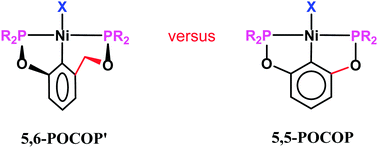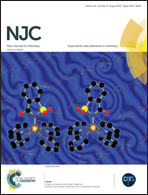Synthesis of unsymmetrical 5,6-POCOP′-type pincer complexes of nickel(ii): impact of nickelacycle size on structures and spectroscopic properties†
Abstract
This report describes the synthesis and characterization of a family of unsymmetrical pincer complexes of nickel(II), featuring both 5- and 6-membered nickelacycles. The room temperature reaction of NiBr2(NCCH3)x with bis(phosphinite) ligand, 1-(i-Pr2PO),3-(i-Pr2POCH2)-C6H4 (POCHOP′), results in direct nickelation at the 2-position of the aromatic ring to give (5,6-POCOP′)NiBr (5,6-POCOP′ = κP,κC,κP′-2-(i-Pr2PO),6-(i-Pr2POCH2)-C6H3). This complex undergoes salt metathesis reactions with M′X to give the corresponding charge neutral derivatives, (5,6-POCOP′)NiX (X = OSO2CF3, OSO2(4-CH3-C6H4), CH3, and C![[triple bond, length as m-dash]](https://www.rsc.org/images/entities/char_e002.gif) CCH3), whereas the abstraction of bromide by AgBPh4 in acetonitrile gave the cationic derivative, [(5,6-POCOP′)Ni(NCCH3)][BPh4]. The new complexes have been characterized by multinuclear NMR spectroscopy and X-ray diffraction studies. The reactivities of the new complexes (5,6-POCOP′)NiX (X = Br, OSO2CF3) have been explored briefly to establish the nucleophilicity of the X ligand and the substitutional lability of the phosphinite moiety in the 6-membered cycle.
CCH3), whereas the abstraction of bromide by AgBPh4 in acetonitrile gave the cationic derivative, [(5,6-POCOP′)Ni(NCCH3)][BPh4]. The new complexes have been characterized by multinuclear NMR spectroscopy and X-ray diffraction studies. The reactivities of the new complexes (5,6-POCOP′)NiX (X = Br, OSO2CF3) have been explored briefly to establish the nucleophilicity of the X ligand and the substitutional lability of the phosphinite moiety in the 6-membered cycle.


 Please wait while we load your content...
Please wait while we load your content...